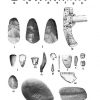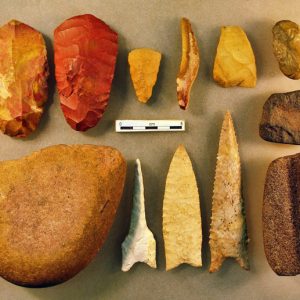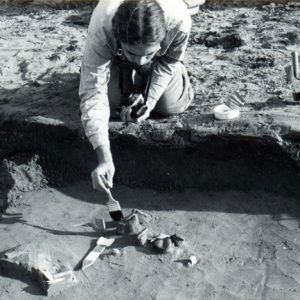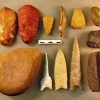calsfoundation@cals.org
Sloan Site
The Sloan site is located on an ice age sand dune in the lowlands of Greene County. People of the Dalton culture buried their dead in ceremonial fashion here about 10,500 years ago. Dalton people were mobile foragers who made and used a distinctive suite of stone tools. These tools have been found at sites across the mid-continental United States. Their material culture that has survived consists primarily of tools made from chert—a highly resistant silica-rich stone that is abundant in the Ozark Mountains, west of the Sloan Site—and in the gravel deposits of Crowley’s Ridge, just east of the Sloan Site. The Sloan Site is one of the oldest, if not the oldest, documented cemeteries in the New World.
The Sloan Site was first recorded by Mary Ann Sloan in June 1968 during an archaeology course she was taking at Arkansas State University (ASU) in Jonesboro (Craighead County). As the site was cleared and cultivated, artifacts were observed across its surface. In 1974, Frank Sloan learned of people collecting and selling artifacts from the Sloan Site and relayed this information to Dr. Dan Morse, station archaeologist for the Arkansas Archeological Survey at ASU. In spite of adverse weather conditions, Morse assembled a crew to excavate the site in March 1974 to prevent further vandalism.
The site covered an area of about 12 x 12 meters. As artifacts were exposed in the large block-style excavation, archaeologists carefully removed the sandy sediment with bamboo picks and paintbrushes. Many tools were in clusters or groups. The discovery locations of more than 400 Dalton artifacts were piece-plotted and catalogued in the field. Most artifacts were also photographed in the locations where they were excavated. More than 450 soil samples were taken for chemical testing. High phosphate levels in the soil suggested the presence of human burials. The sedimentary context of the Sloan site was shallow and sandy—poor conditions for the preservation of bone. Nevertheless, a total of 211 bone fragments from 141 catalogued locations were recovered during the excavation. Dr. Jerome Rose and colleagues at the University of Arkansas (UA) in Fayetteville (Washington County) analyzed the bone fragments: 64 percent were identified as unquestionably human, 18 percent were probably human, 10 percent were possibly human, and 8 percent were indeterminate. No bone fragment was identified as non-human. The variation in thickness of human cranial fragments indicates that both juveniles and adults were buried at the Sloan cemetery. The spatial patterning of artifacts and bone suggests there were twenty-eight to thirty people buried at the cemetery.
All of the types of known tools in the Dalton tool kit were recovered from the Sloan site. Microscopic analysis was used to determine how tools were used and on what materials they were used. The tools recovered from Sloan are not necessarily specially made grave goods but instead appear to be essential items for conducting day-to-day activities, such as cutting and scraping plant foods and wood; scraping and perforating hides to make clothing and footwear; incising bone, antler, and wood; chopping and scraping wood for spears, tool handles, shelters, and canoes; cracking nuts; crushing pigment; and manufacturing chert tools. Dalton tools also may have had symbolic significance. There is one Dalton biface in particular that may have been more of a symbol than a useful tool. It is extremely long, wide, and thin and is called a “Sloan Dalton.” Several dozen Sloan Dalton bifaces have been found in states along the Mississippi River from Illinois to Arkansas.
A total of 439 artifacts (mostly chipped stone) were recovered during the month-long excavation at Sloan, including 146 Dalton points, forty-two adzes, ninety-five bifaces, thirty-three end scrapers, nine backed unifaces, fifty-nine flake tools, three chert hammers, five cores, thirty-five sandstone abraders, five cobble tools, five red ochre lumps, and one piece of ironstone. The majority of chipped stone tools from Sloan were made of Crowley’s Ridge chert, which is the closest source of chert to the Sloan Site, but Dalton people also used a wide variety of chert types from the Ozarks (Penters, Pitkin, Jefferson City, Reeds Spring, Plattin) to fashion some of their tools. Some of these chert source areas are located from sixty to 100 kilometers from the site, and they can be found in colors and piece sizes that may have been preferred over Crowley’s Ridge chert. Because of its remarkable spatial integrity and artifact assemblage, the Sloan Site is one of the most significant Dalton sites ever investigated. If the interpretation that the Sloan Site is a cemetery is correct, then it appears that Dalton people had a strong sense of place in the western lowlands of Arkansas. Due to the efforts of John Sloan and E. Sloan Farms, the site is now owned by the Archaeological Conservancy.
For additional information:
Morrow, Juliet E. “The Sloan Site (3GE94) Assemblage Revisited: Chipped Stone Raw Material Procurement and Use in the Cache Basin.” Missouri Archaeologist 71 (2011): 5–40.
Morse, Dan. Sloan: A Paleoindian Dalton Cemetery in Arkansas. Washington DC: Smithsonian Institution Press, 1997.
“Sloan Site Artifacts.” Arkansas Archeological Survey. http://archeology.uark.edu/sloan/ (accessed January 24, 2022).
Juliet E. Morrow
Arkansas Archeological Survey

 Dalton Tools
Dalton Tools  Sloan Site
Sloan Site 




Comments
No comments on this entry yet.